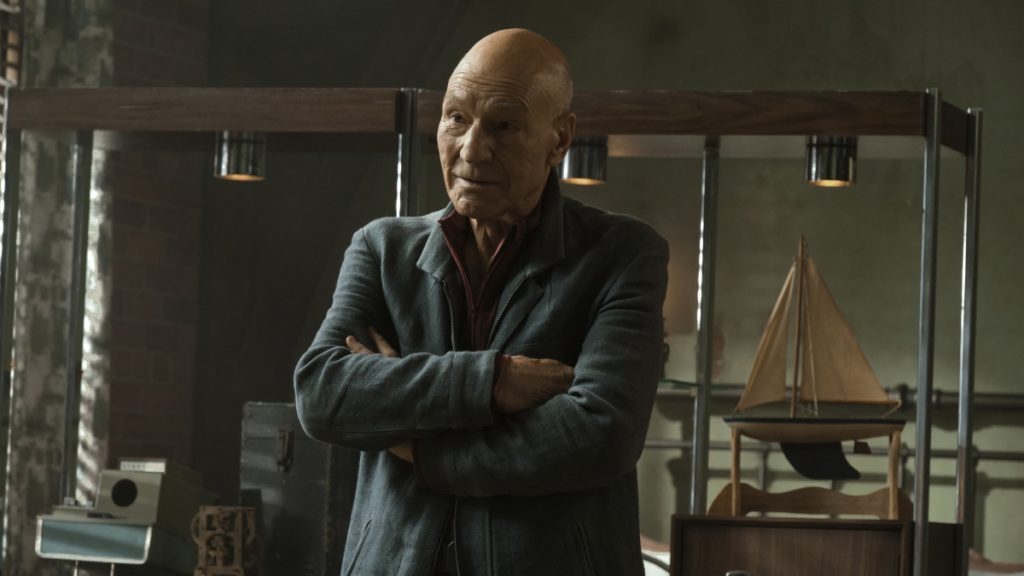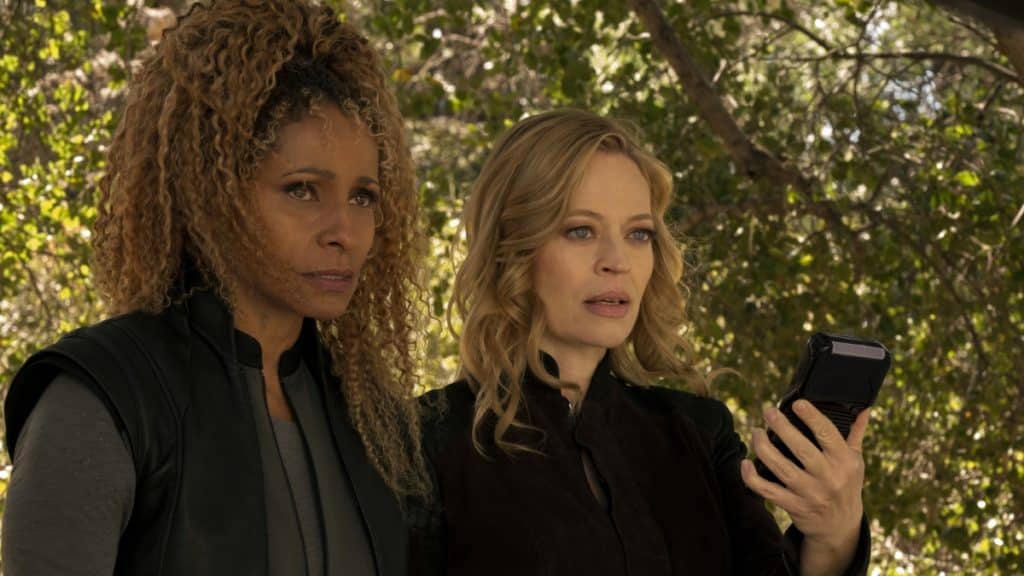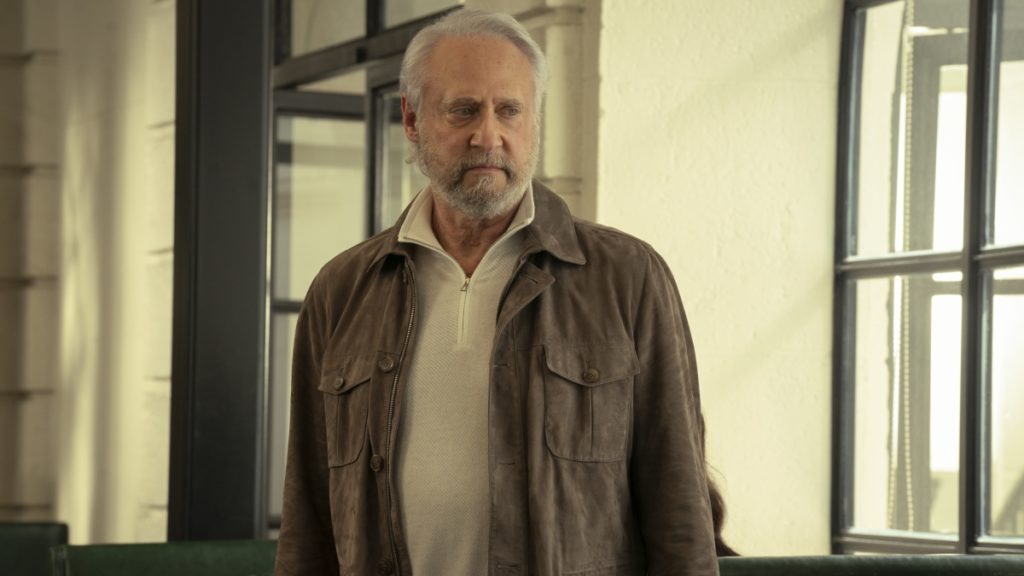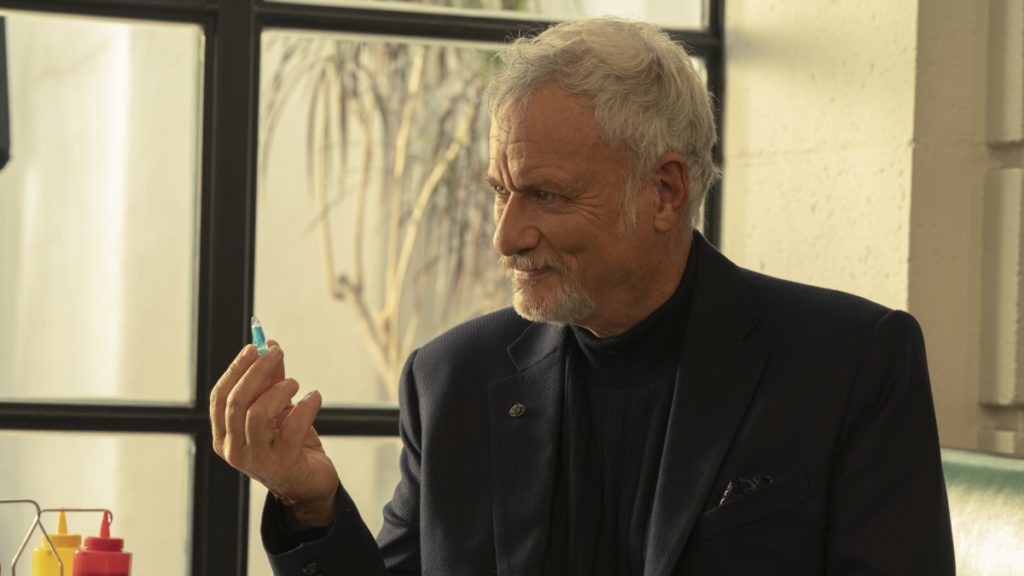A plethora of familiar faces and reheated plots sink Jean-Luc’s 2024 adventures.
The term “fan fiction” flows too easily as a pejorative these days. Star Trek fans, of all people, should be accommodating. Although Trekkies didn’t invent unofficial stories featuring popular characters, they certainly popularized them in the modern era. There’s a robust tradition of writers, especially those marginalized in more traditional media spaces, finding their voices or having fun using familiar settings and characters to tell their own stories.
When people deride something as fan fiction, they tend to mean that it conforms to some unfortunate stereotypes. Some of that amounts to plot points that are too shaggy or nonsensical. Some of it comes down to protagonists who succeed by fiat rather than earn their wins. The biggest hallmark is stories that merely reference and regurgitate what the audience already knows and likes. Meanwhile, they offer nothing new, relying on familiar faces and names repeated ad nauseam.
By that measure, “Fly Me to the Moon” is the most fan fiction-y hour of Star Trek: Picard yet. Of course, Jean-Luc’s (Patrick Stewart) jaunt to the twenty-first century already involved the former captain running into his old bar buddy, not to mention the spitting image of the amiable caretaker with whom he’d shared a DOA flirtation. But by Jove, for some godforsaken reason, that’s not enough.

Larys (Orla Brady), or someone who looks nearly identical, is actually a powerful “supervisor” a la Gary Seven from Gene Roddenberry’s abortive backdoor pilot in The Original Series season 2 finale. And Q (John de Lancie) is back in action, reaching out to yet another Soong ancestor who looks like Brent Spiner, this time with a daughter who looks like Soji (Isa Briones). The big event our heroes must protect from disaster is another historic space flight a la Star Trek: First Contact. It also just happens to involve one Renee Picard (Penelope Mitchell), who turns out to be Jean-Luc’s ancestor.
Any one of these fan service-y story choices would be cheesy and unimaginative on their own. But bundled together, they make the broader arc seem creatively bankrupt. The first season of Star Trek: Picard had its share of problems and didn’t hesitate to bring back Data, Riker, and Troi for splashy cameos. But the most admirable quality in that first batch of episodes was the writers’ willingness to take some of the least-loved elements of recent canon — Data’s death in Nemesis and the destruction of the Vulcan homeworld in Star Trek ’09 — and build on the consequences of them. They found novel, challenging ways rather than just rehashing the favored and familiar.
Not all of those choices worked out. Some of them were downright awful. But whatever season 1’s sins, showrunner Michael Chabon and his team had the chutzpah to use the franchise’s past as a jumping off point for a new crew and a new adventure. For better or worse, they took chances and presented something different than viewers had seen before.

On the other hand, “Fly Me to the Moon” may as well be a shabby attempt at a greatest hits record for Jean-Luc and company. Redoing the “Picard’s crew helps an important launch happen” plot from the best-received TNG film is already a stretch. In fairness, recycling plots is a proud Star Trek tradition. What’s beyond the pale is to stoop to making the critical astronaut Picard’s great great great (etc.) aunt. It suggests no one in this season can exist without being connected to someone the audience already knows.
It adds to the small universe problem an increasing number of big franchises suffer from these days. Finding a relative of Picard’s, who’s also a space explorer and strongly implied to be the key to fixing the timeline, is a contrivance that doesn’t trust viewers to care about anyone not connected to a known character. The best that one can say for this development is that ST:P seems poised to use Renee to address salient topics like depression and anxiety. But given the ham-fisted dialogue and dramatizations so far, the hope for a good outcome on that front remains slim.
That’s all before we get to yet another character in the Star Trek universe who’s tangentially related to Data and played by Brent Spiner. Enlisting him to play Data’s evil twin on The Next Generation was cute. It was a welcome chance for Spiner to cut loose from the android’s usual stoicism. Casting him as Data’s creator, a man egotistical enough to design an android in his own image, is clever enough. But bringing Spiner back to play a eugenicist involved with the Augments (read: Khan) on Star Trek Enterprise? Or a never-before-mentioned biological son of Noonien Soong last season, and now yet another “Dr. Soong,” this one a geneticist in 2024? That reeks of lazy fan service and diminishing returns.
On the other hand, “Fly Me to the Moon” may as well be a shabby attempt at a greatest hits record for Jean-Luc and company.
Nevermind the fact that Briones is back too for some reason, now playing Soong’s daughter. Why? It’s established that Data was created to resemble his “father.” Did Altan Inigo Soong (Noonien’s aforementioned biological son) design Soji to resemble his great great great (etc.) grandmother for some reason? Or do all male Soongs look like Spiner and all female Soongs look like Briones? Spread the genes, people!
There’s juice in the idea that what spurred Soongs toward genetic and cybernetic experimentation began with a father trying to save his daughter. But none of it makes any sense. The only reason for another set of Starfleet officers to cross paths with another set of Soongs is because the audience already knows the actors and characters involved. Spiner standing across from de Lancie or interacting with one of Data’s spiritual offsprings still excites. That trumps whether it ultimately amounts to something worthwhile for this show and this story.

Even setting aside the smorgasbord of fan service-y contrivances, the structure and pacing of this installment is outright bad. The opening features an out-of-place conclusion to the “Seven (Jeri Ryan) and Raffi (Michelle Hurd) rescue Rios (Santiago Cabrera)” cliffhanger from the last episode. The end features about one-fifth of a heist story that comes out of nowhere. And in between is one big lumpy middle. The episode leaps between major characters who are only now being introduced halfway through the season. And it’s rife with painful exposition dumps featuring Jean-Luc and the prickly new ally who resembles his current love interest and is willing to team up with him at the drop of a hat despite her own “non-interference” pact.
This, too, is separate and apart from the baffling developments in Dr. Jurati’s (Alison Pill) storyline. The Borg Queen (Annie Wersching) manages to lure a French police officer into investigating Chateau Picard, and the twists only grow dumber from there.
The constable somehow spots the cloaked ship in the mists but misses Agnes sleeping on the couch right next to him. Despite seemingly being neutralized, Queenie has a fifth tentacle that she didn’t use on any of the main cast because they have plot armor. Still, she’s happy to use it to hold this random disposable nobody hostage. And suppose that’s not implausible and convenient enough for you? In that case, the show delivers a fakeout of Agnes killing the Queen, only to reveal the Borg ruler injected her virtual essence into Dr. Jurati at the last minute.

All of it strains credulity in a show where the fantastical technology at play ought to make just about anything possible. There’s the germ of a decent idea with Borg assimilation placed in opposition to Agnes’ deep-seated fear of being alone. But a raft of plot-mandatory nonsense leading to Jurati and Queenie pulling a Dexter-esque imaginary friend routine is not an appetizing result.
Nothing here is. Usually, even in the worst Star Trek episodes, there’s something redeeming, some positive elements to appreciate amid the tumult. Unfortunately, “Fly Me to the Moon” has practically nothing. De Lancie is still a hoot as Q, with a tinge more menace than usual. However, he’s shunted into the plainest of audience-pandering, threadbare plots. The notion of human history resting on an astronaut struggling with anxiety and depression is a robust setup. Unfortunately, the episode spends more time on who she’s related to than who she is. The best moment is when Raffi points out how strange and ridiculous this charade has become.
It’s a reminder that poor, pandering stories run from the most endearingly amateur efforts to the most polished productions. With all the talent and budget at Star Trek: Picard’s disposal, the creative team can do better. We don’t need yet another example of the great snake of the galaxy eating its tail repeatedly. An installment like this one, full of bungled storytelling and cheap callbacks, shouldn’t be called fan fiction. It doesn’t deserve the honor.
Read next: The Spool's Best New Releases
Streaming guides
The Best Live TV Streaming Services With Free Trial
The praises of live TV streaming services don’t need to be further sung. By now, we all know that compared to clunky, commitment-heavy cable, live TV is cheaper and much easier to manage. But just in case you’re still on the fence about jumping over to the other side, or if you’re just unhappy with ... The Best Live TV Streaming Services With Free Trial
How to Watch Power Book III: Raising Kanan Season 3
Season 3 of the hotly anticipated Power spin-off, Power Book III: Raising Kanan, is arriving on Starz soon, so you know what that means: it’s the ’90s again in The Southside, and we’re back with the Thomas family as they navigate the ins and outs of the criminal underworld they’re helping build. Mekai Curtis is ... How to Watch Power Book III: Raising Kanan Season 3
How to Watch Doctor Who: 60th Anniversary Specials
Ladies and gentlemen, we’re so back! To celebrate Doctor Who’s 60th anniversary, the BBC is producing a three-episode special starring none other than the Tenth/Fourteenth Doctor himself, David Tennant. And to the supreme delight of fans (that would be me, dear reader), the Doctor will be joined by old-time companion Donna Noble (Catherine Tate) and ... How to Watch Doctor Who: 60th Anniversary Specials
Which Netflix Country has Interstellar?
Maybe you’ve just seen Oppenheimer and have the strongest urge to marathon—or more fun yet, rank!—all of Christopher Nolan’s films. Or maybe you’re one of the few who haven’t seen Interstellar yet. If you are, then you should change that immediately; the dystopian epic is one of Nolan’s best, and with that incredible twist in ... Which Netflix Country has Interstellar?
Which Netflix Country Has Each Movie of The Hunger Games?
For whatever reason, The Hunger Games series isn’t available in the same countries around the world. You’ll find the first and second (aka the best) installments in Hong Kong, for instance, but not the third and fourth. It’s a frustrating dilemma, especially if you don’t even have a single entry in your region, which is ... Which Netflix Country Has Each Movie of The Hunger Games?
How to Watch ESPN With A Free Trial
One of the major concerns people have before cutting the cord is potentially losing access to live sports. But the great thing about live TV streaming services is that you never lose that access. Minus the contracts and complications of cable, these streaming services connect you to a host of live channels, including ESPN. So ... How to Watch ESPN With A Free Trial
How to Watch Paramount Network With a Free Trial
To date, Paramount Network has only two original shows on air right now: Yellowstone and Bar Rescue. The network seems to have its hands full with on-demand streaming service Paramount+, which is constantly stacked with a fresh supply of new shows. But Yellowstone and Bar Rescue are so sturdy and expansive that the network doesn’t ... How to Watch Paramount Network With a Free Trial
How to Watch WE TV With a Free Trial
Previously “Women’s Entertainment,” We TV has since rebranded to accurately reflect its name and be a more inclusive lifestyle channel. It’s home to addictive reality gems like Bold and Bougie, Bridezillas, Marriage Boot Camp, and The Untold Stories of Hip Hop. And when it’s not airing original titles, it has on syndicated shows like 9-1-1, ... How to Watch WE TV With a Free Trial
How to Watch TNT Sports With A Free Trial
For many sports fans, TNT is a non-negotiable. It broadcasts NBA, MLB, NHL, college basketball, and All Elite Wrestling matches. And, as a bonus, it also has reruns of shows like Supernatural, Charmed, and NCIS, as well as films like The Avengers, Dune, and Justice League. But while TNT used to be a cable staple, ... How to Watch TNT Sports With A Free Trial
How to Watch Comedy Central With a Free Trial
It’s no coincidence that many of today’s biggest comedians found their footing on Comedy Central: the channel is a bastion of emerging comic talents. It served as a playground for people like Nathan Fielder (Fielder For You), Ilana Glazer and Abbi Jacobson (Broad City), Tim Robinson (Detroiters), and Dave Chappelle (Chappelle’s Show) before they shot ... How to Watch Comedy Central With a Free Trial
How to Watch FX With a Free Trial
You’d be hard-pressed to find a bad show airing on FX. The channel has made a name for itself as a bastion of high-brow TV, along with HBO and AMC. It’s produced shows like Atlanta, Fargo, The Americans, Archer, and more recently, Shogun. But because it’s owned by Disney, it still airs several blockbusters in ... How to Watch FX With a Free Trial